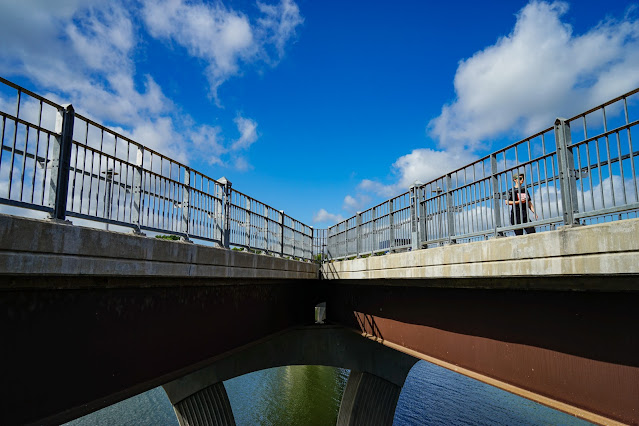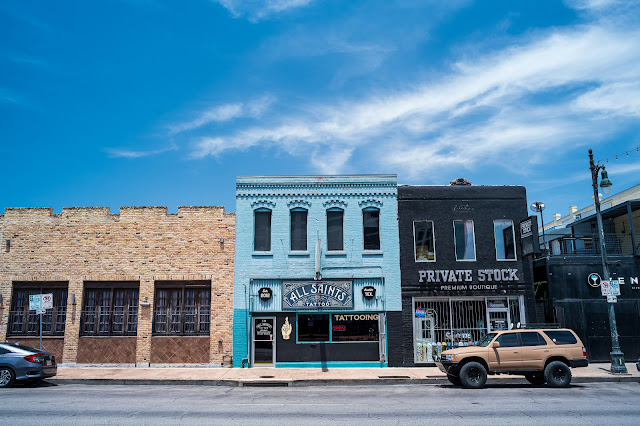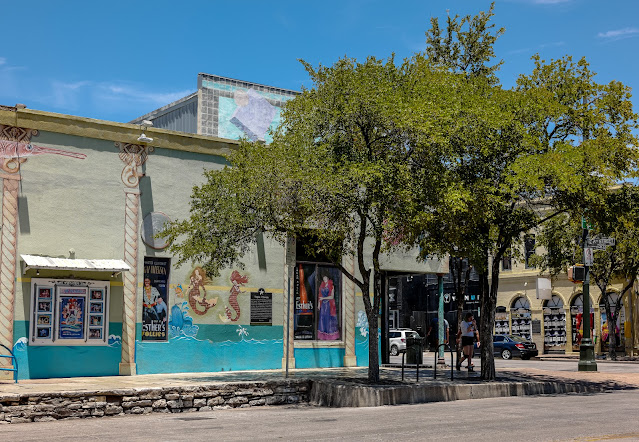
8.02.2022
The Sky Is The Limit. Endless Blue Skies Over Texas. And a "Progress Report" from Austin.

8.01.2022
The end of photography is nigh. The economy is falling apart. But...
I answered emails today and got booked far ahead for a corporate event starting on the17th of November and a more detailed project starting on October 24th. Both traditional commercial photography.
In other news clients are paying their bills quicker. About a five day gap between billing and receiving payment these days. Based on this year's transactions.
And...clients are taking price increases in stride. We've raised rates by between 20 and 30% this year (depending on the type of assignment) with no push back from nearly a dozen clients to date.
We're trying to track our billing to inflation and our track our spending with a recession in mind. It's all a crap shoot but I'm not really seeing any of the doom and gloom come to fruition.
I am seeing the trees and landscape drying out and turning brown. But business? Still green.
One of the Google buildings in downtown.
Long term clients are a nice thing to have.
The dystopian edit and the non-dystopian edits.
These are not exactly the same frame. They are sequential frames. Each edited in its own way.
Sample images by request of a reader...
Polarizing Filters and Magic Skies. Cheap pre-post-processing.
7.31.2022
Poor Man's Construct of a Passable Leica Q or Q2 Competitor... Vroom.

7.30.2022
A Chef. And tiny, ancient camera bokeh.
I used the version one version of the Leica Summilux 25mm f1.4 with a working aperture of f2.5. The shutter speed was 1/125th of a second and the ISO was set at 640. I think we were able to make it work.
In a moment of incoherence I sold my first 25mm Summilux to another photo blogger. When I got back into the system this past year it was one of the very first lenses I replaced. But this time I bought the second generation. Works better with DfD and it's better weather sealed. Optics are reported to be the same. Those standard angle of view lenses are crucial for every format. At least I think so...
Bokeh-O-Rama in the service of advertising.
I was reminiscing about all the DSLR cameras I've used and I came across a lot of images we made while using one of the stars of the DSLR epoch; the Canon 5Dmk2. This image was a combination of available light at ISO 100, 1/13th of a second shutter speed and an aperture of f2.8 mixed with some soft electronic flash from the front. I was using an 85mm f1.8 lens.
It's a text book example of how we used to use the ability to render a background out of focus before the more recent trend of slivering the depth of field to the width of a gnat's whisker. In the days before micro slicing depth of field we tried to keep an image in focus enough to keep out main subject nicely sharp while putting the background into the "recognizable, but vague" category, which covers a myriad of styling sins...
By using a bit of aperture restraint we are still able to see that our subject has both ears and that his shirt is wrinkly instead of looking as soft as pudding.
Accidents and mishaps derail the quiet life. But we're not going to make this a new hobby...
7.29.2022
The Best Camera Sony ever made. Considering not just image quality but also handling, battery life, and great lens choice.
Of all the cameras I've used from Sony (a850, a77, a57, A7ii, A7rii, RX10, RX10iii, Nex-7, etc.) the one that always stands out by a wide margin from all the rest as an all-around winner has got to be the a99. It was a full framer, with the semi-transparent non-moving mirror, a super nice 24 megapixel sensor and a selection of really stellar glass. It also had a color science to it that ended with that model.
I always thought of it as the last brilliant thrust of Minolta engineering before the photography department of Sony was totally overthrown by a new staff of boring camera engineers and equally lackluster marketing teams.
The color out of that specific camera was beautiful and the lenses were amazing. The 70-200mm f2.8 was especially good.
I was sad to let the system go but it was becoming quickly apparent that this would be an orphaned construct that would cease to be supported at all in very short order.
This was a working shot from a video course I did back in 2013 for Craftsy.com. A fresh face. A nice lens and some playful lighting.
Sad when new owners of technology homogenize out the secret sauce and move on.
R.I.P. Sony a99. (Or should I say: Minolta a99?)
7.27.2022
My new, standard, normal 50mm equivalent for the CL and TL2.
We're forever testing the gear in that primordial oven we call: Downtown Austin. So, how is the Bokeh with the Sigma 35mm f2.0 we've heard so much about? Is it...bokeh-licious?
This was a test shot from today. Actually, the last shot on a long and hot tromp through the city. It was photographed with the 35mm lens but today I was using it on a Leica CL which is a camera with a smaller, APS-C sensor.
I was curious to see how the background and bokeh would look if I used the lens at its maximum aperture. Would it be "wooly"? "wire-y"? "tense"? "aggravated"? "finicky"? "melancholy?" or just plodding and pensive?
Truth be told, I am not a particularly good judge of bokeh but I found it to be intransigent, jejune, and anti-mordantic.
I would defer to the experts among us, if any are brave enough to step in and talk about the quality of this lens's out of focus areas. Have a swing at it. You couldn't do worse than me.
Maybe it's gloppy with soft and mellow fringes.... Who can know? Perhaps I should run it by the experts at DPR...
A new spec for reviews: "Taken at 103°"
Swimming cold during a brutally hot Summer. Benefits.
If you are a regular reader of the blog you are probably tired of reading about swimming but... the powers that be just put me in charge of content again so you'll have to be a bit patient.
I have been swimming for the better part of three decades at the Rollingwood Pool. I swim there because their masters swim program attracts world class coaches and thoughtful, disciplined swimmers who are also incredibly nice people. People who are able to balance their competitive streaks with the ability to get along and also have fun. The program runs coached masters workouts twice a day, six days a week and then the pool is closed on Mondays. The water has to rest sometime...
Swimming at the pool this Summer has been a challenge. Nothing has changed in the coaching or the swimmers but the unbroken heatwave ( so far 45 days in the triple digits!!! ) is making it nearly impossible to keep the water cool enough. We use big aerators at night to cool the water but since the water coming out of the taps is about 86° and the pool is in direct sun for most of each day the actual pool water temperature has creeped up from our usual (and preferred) 80° to about 85° as of yesterday.
We can still swim in it but we have to swim slower, add more time to intervals, shorten the sets, etc. When the water temperature is too warm human core temperatures rise, there is an osmotic effect that accelerates dehydration and the heat makes everything more fatiguing. Our coaches are constantly encouraging us to drink more fluids and they are keeping a closer eye on everyone, watching for sign of heat stress.
Last week I wanted to swim on Monday. I had gotten a Senior Swim Pass from the city of Austin which gives me ready access to the city pools. There is one pool in particular that I always enjoy but I won't name it here because it's already over-attended. It's an old WPA pool that sits adjacent to Lady Bird Lake. It's not chlorinated because it's filled with fresh spring water that's usually a constant 70°. It gets drained and refilled a couple times a week. But......SEVENTY DEGREES !!!....that's pure gold.
And in the first hours of the morning (opens at 8) the many lap lanes are in the shade. The main pool is open only to lap swimmers from 8 - noon so there are no kids to dodge and no floating, lazy people littering the lanes to mess up good, long distance swims. There are strict rules about circle swimming or split lane swimming and anyone who doesn't want to play by the rules gets tossed out. In short, my kind of pool.
So, I went last week on Monday and the difference in water temperature was shocking, invigorating and heavenly. Swimming in cold water for me means I can go longer, harder, faster and better in the same amount of time I usually spend at workout. I knocked out 4,000 yards and felt no more tired than when I arrived.
But I missed swimming with my team (although I swam in a lane adjacent to my old kinesiology coach from UT, circa 1974) so I had decided just to make the "cold" swim a Monday thing. I went again this week on Monday, had my own lane, did a lot of fast yardage and had a blast.
It was back to my regular swim club on Tuesday and back to the heat. I enjoyed being in sync with my perennial swim buddies but the difference between Monday's swim and Tuesday's swim was striking. So, this morning I was back at the cold pool. I'm guessing the rest of the Summer is going to be an exercise in moving back and forth between the hot pool and the cold pool. The group, coached swims and the pensive, driven loner swims. But at least the options exist.
There was an article on the CNN news feed this morning about exercise and longevity. Apparently there is no necessary upper limit to exercise but people who exercise above the WHO recommendations live longer. And better. They have lower mortality from all causes than people who exercise less. The commonly cited baseline recommendation for exercise is between 75 minutes and 150 minutes of solid exercise a week. I think these recommendation should be for each day. The study presented recommended 300+ minutes of exercise a week and also recommended that about half of those exercise minutes be "vigorous."
Playing snooker or bowling were NOT included in the recommended vigorous exercises. (See "Games, NOT exercise" from the Society of Data-Free Research for more about the exercise futility of games...). Included were jogging or running, soccer, fast swimming, etc.
Since the dawn of recorded history people in nearly all cultures have been looking for the "Fountain of Youth" or the secrets of extending one's lifespan. Looks like we have, in fact, discovered the secret to adding years and years to your life by doing a good bit of exercise. And living those years in better health. The sad thing is that most people will disregard the research, find a comfortable chair in front of the computer, TV or video game console, munch on some pizza, drink a diet Coke and resolve to start an exercise "program" next year. So, free, healthy extra years are currently for sale for the price of a bit of sweat and discipline and there are very few takers. Now that is sad.



























-2.jpg)

















